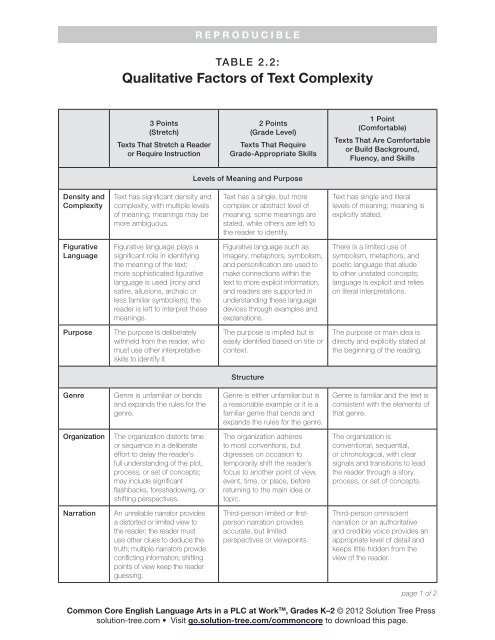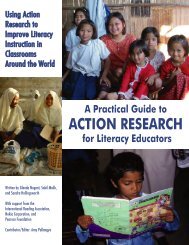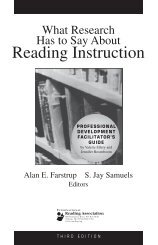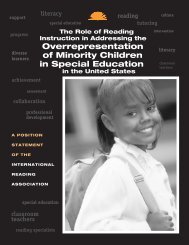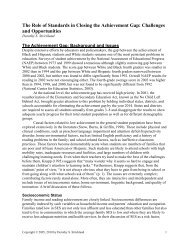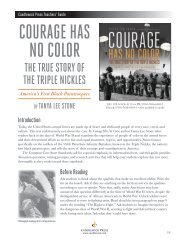Table 2.2: Qualitative Factors of Text Complexity
Table 2.2: Qualitative Factors of Text Complexity
Table 2.2: Qualitative Factors of Text Complexity
Create successful ePaper yourself
Turn your PDF publications into a flip-book with our unique Google optimized e-Paper software.
REPRODUCIBLE<br />
TABLE <strong>2.2</strong>:<br />
<strong>Qualitative</strong> <strong>Factors</strong> <strong>of</strong> <strong>Text</strong> <strong>Complexity</strong><br />
3 Points<br />
(Stretch)<br />
<strong>Text</strong>s That Stretch a Reader<br />
or Require Instruction<br />
2 Points<br />
(Grade Level)<br />
<strong>Text</strong>s That Require<br />
Grade-Appropriate Skills<br />
1 Point<br />
(Comfortable)<br />
<strong>Text</strong>s That Are Comfortable<br />
or Build Background,<br />
Fluency, and Skills<br />
Levels <strong>of</strong> Meaning and Purpose<br />
Density and<br />
<strong>Complexity</strong><br />
<strong>Text</strong> has significant density and<br />
complexity, with multiple levels<br />
<strong>of</strong> meaning; meanings may be<br />
more ambiguous.<br />
<strong>Text</strong> has a single, but more<br />
complex or abstract level <strong>of</strong><br />
meaning; some meanings are<br />
stated, while others are left to<br />
the reader to identify.<br />
<strong>Text</strong> has single and literal<br />
levels <strong>of</strong> meaning; meaning is<br />
explicitly stated.<br />
Figurative<br />
Language<br />
Figurative language plays a<br />
significant role in identifying<br />
the meaning <strong>of</strong> the text;<br />
more sophisticated figurative<br />
language is used (irony and<br />
satire, allusions, archaic or<br />
less familiar symbolism); the<br />
reader is left to interpret these<br />
meanings.<br />
Figurative language such as<br />
imagery, metaphors, symbolism,<br />
and personification are used to<br />
make connections within the<br />
text to more explicit information,<br />
and readers are supported in<br />
understanding these language<br />
devices through examples and<br />
explanations.<br />
There is a limited use <strong>of</strong><br />
symbolism, metaphors, and<br />
poetic language that allude<br />
to other unstated concepts;<br />
language is explicit and relies<br />
on literal interpretations.<br />
Purpose<br />
The purpose is deliberately<br />
withheld from the reader, who<br />
must use other interpretative<br />
skills to identify it.<br />
The purpose is implied but is<br />
easily identified based on title or<br />
context.<br />
The purpose or main idea is<br />
directly and explicitly stated at<br />
the beginning <strong>of</strong> the reading.<br />
Structure<br />
Genre<br />
Genre is unfamiliar or bends<br />
and expands the rules for the<br />
genre.<br />
Genre is either unfamiliar but is<br />
a reasonable example or it is a<br />
familiar genre that bends and<br />
expands the rules for the genre.<br />
Genre is familiar and the text is<br />
consistent with the elements <strong>of</strong><br />
that genre.<br />
Organization<br />
The organization distorts time<br />
or sequence in a deliberate<br />
effort to delay the reader’s<br />
full understanding <strong>of</strong> the plot,<br />
process, or set <strong>of</strong> concepts;<br />
may include significant<br />
flashbacks, foreshadowing, or<br />
shifting perspectives.<br />
The organization adheres<br />
to most conventions, but<br />
digresses on occasion to<br />
temporarily shift the reader’s<br />
focus to another point <strong>of</strong> view,<br />
event, time, or place, before<br />
returning to the main idea or<br />
topic.<br />
The organization is<br />
conventional, sequential,<br />
or chronological, with clear<br />
signals and transitions to lead<br />
the reader through a story,<br />
process, or set <strong>of</strong> concepts.<br />
Narration<br />
An unreliable narrator provides<br />
a distorted or limited view to<br />
the reader; the reader must<br />
use other clues to deduce the<br />
truth; multiple narrators provide<br />
conflicting information; shifting<br />
points <strong>of</strong> view keep the reader<br />
guessing.<br />
Third-person limited or firstperson<br />
narration provides<br />
accurate, but limited<br />
perspectives or viewpoints.<br />
Third-person omniscient<br />
narration or an authoritative<br />
and credible voice provides an<br />
appropriate level <strong>of</strong> detail and<br />
keeps little hidden from the<br />
view <strong>of</strong> the reader.<br />
page 1 <strong>of</strong> 2<br />
Common Core English Language Arts in a PLC at Work TM , Grades K–2 © 2012 Solution Tree Press<br />
solution-tree.com • Visit go.solution-tree.com/commoncore to download this page.
REPRODUCIBLE<br />
3 Points<br />
(Stretch)<br />
<strong>Text</strong>s That Stretch a Reader<br />
or Require Instruction<br />
2 Points<br />
(Grade Level)<br />
<strong>Text</strong>s That Require<br />
Grade-Appropriate Skills<br />
1 Point<br />
(Comfortable)<br />
<strong>Text</strong>s That Are Comfortable<br />
or Build Background,<br />
Fluency, and Skills<br />
Structure<br />
<strong>Text</strong><br />
Features<br />
and<br />
Graphics<br />
There is limited use <strong>of</strong> text<br />
features to organize information<br />
and guide the reader.<br />
Information in the graphics is<br />
not repeated in the main part<br />
<strong>of</strong> the text but is essential for<br />
understanding the text.<br />
Has a wider array <strong>of</strong> text<br />
features including margin<br />
notes, diagrams, graphs, font<br />
changes, and other devices<br />
that compete for the reader’s<br />
attention; graphics and visuals<br />
are used to augment and<br />
illustrate information in the main<br />
part <strong>of</strong> the text.<br />
<strong>Text</strong> features (such as bold<br />
and italicized words, headings,<br />
and subheadings) organize<br />
information explicitly and<br />
guide the reader; graphics or<br />
illustrations may be present but<br />
are not necessary to understand<br />
the main part <strong>of</strong> the text.<br />
Language Conventionality and Clarity<br />
Standard<br />
English and<br />
Variations<br />
The text includes significant<br />
and multiple styles <strong>of</strong> English<br />
and its variations, and these are<br />
unfamiliar to the reader.<br />
Some distance exists between<br />
the reader’s linguistic base and<br />
the language conventions used<br />
in the text; the vernacular used is<br />
unfamiliar to the reader.<br />
The language closely adheres<br />
to the reader’s linguistic base.<br />
Register<br />
The register is archaic, formal,<br />
domain specific, or scholarly.<br />
The register is consultative or<br />
formal, and may be academic<br />
but acknowledges the<br />
developmental level <strong>of</strong> the reader.<br />
The register is casual and<br />
familiar.<br />
Knowledge Demands<br />
Background<br />
Knowledge<br />
The text places demands<br />
on the reader that extend far<br />
beyond his or her experiences,<br />
and provides little in the way <strong>of</strong><br />
explanation <strong>of</strong> these divergent<br />
experiences.<br />
There is distance between<br />
the reader’s experiences and<br />
those in the text, but there is<br />
acknowledgement <strong>of</strong> these<br />
divergent experiences, and<br />
sufficient explanation to bridge<br />
the gaps.<br />
The text contains content that<br />
closely matches the reader’s life<br />
experiences.<br />
Prior<br />
Knowledge<br />
Presumes specialized or<br />
technical content knowledge<br />
and little in the way <strong>of</strong> review or<br />
explanation <strong>of</strong> these concepts<br />
is present in the text.<br />
Requires subject-specific<br />
knowledge, but the text<br />
augments this with review or<br />
summary <strong>of</strong> this information.<br />
The prior knowledge needed<br />
to understand the text is<br />
familiar, and it draws on a solid<br />
foundation <strong>of</strong> practical, general,<br />
and academic learning.<br />
Cultural<br />
Knowledge<br />
The text relies on extensive or<br />
unfamiliar intertextuality and<br />
uses artifacts and symbols that<br />
reference archaic or historical<br />
cultures.<br />
The text primarily references<br />
contemporary and popular<br />
culture to anchor explanations<br />
for new knowledge; intertextuality<br />
is used more extensively but is<br />
mostly familiar to the reader.<br />
The reader uses familiar cultural<br />
templates to understand the<br />
text with limited or familiar<br />
intertextuality.<br />
Vocabulary<br />
Knowledge<br />
Vocabulary demand is<br />
extensive, domain specific,<br />
and representative <strong>of</strong> complex<br />
ideas; the text <strong>of</strong>fers little in the<br />
way <strong>of</strong> context clues to support<br />
the reader.<br />
Vocabulary draws on domain<br />
specific, general academic,<br />
and multiple meaning words,<br />
with text supports to guide the<br />
reader’s correct interpretations<br />
<strong>of</strong> meanings; the vocabulary<br />
represents familiar concepts<br />
and ideas.<br />
Vocabulary is controlled and<br />
uses the most commonly held<br />
meanings; multiple meaning<br />
words are used in a limited<br />
fashion.<br />
Source: Adapted from Fisher et al., 2012. page 2 <strong>of</strong> 2<br />
Common Core English Language Arts in a PLC at Work TM , Grades K–2 © 2012 Solution Tree Press<br />
solution-tree.com • Visit go.solution-tree.com/commoncore to download this page.


